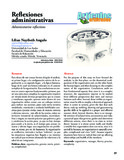Mostrar el registro sencillo del ítem
Reflexiones administrativas
| dc.rights.license | http://creativecommons.org/licenses/by-nc-sa/3.0/ve/ | |
| dc.contributor.author | Angulo Hernández, Lilian Nayive | |
| dc.date.accessioned | 2016-08-01T22:52:26Z | |
| dc.date.available | 2016-08-01T22:52:26Z | |
| dc.date.issued | 2016-01 | |
| dc.identifier.issn | 1316-4910 | |
| dc.identifier.uri | http://www.saber.ula.ve/handle/123456789/42214 | |
| dc.description.abstract | Para efecto de este ensayo hemos dirigido el análisis, en primer lugar, a la configuración teórica de la organización y, en segundo lugar, a la figura humana, luego de lo cual nos hemos enfocado en el carácter complejo de la organización. Las conclusiones se centran en cuatro aspectos fundamentales: primero, por ser una estructura compleja, la organización requiere ser mirada desde diversas perspectivas que se cruzan y entrelazan; segundo, quienes están dentro de una organización deben contar con un enfoque teórico para realizar sus acciones, pues cada teoría termina modelando, enseñando y avalando habilidades concretas para ejecutar ciertas cosas de manera correcta y eficiente; tercero, más allá de las teorías, existe un territorio inmaterial de subjetividades, incertidumbres y riesgos; un mundo práctico que gobierna, guía y condiciona la acción pura, ya que no hay tiempo para acudir a la teoría, es el tiempo para actuar; en cuarto y último lugar, una organización sin problemas no existe; por ser de humanos, la organización es conflictiva, intricada e incluso “enferma”, ya que las situaciones negativas han llegado a un extremo tan radical que terminan afectando las relaciones y la salud de sus integrantes. | es_VE |
| dc.language.iso | es | es_VE |
| dc.publisher | SABER-ULA | es_VE |
| dc.rights | info:eu-repo/semantics/openAccess | |
| dc.subject | Organización | es_VE |
| dc.subject | Gerente | es_VE |
| dc.subject | Teoría | es_VE |
| dc.subject | Práctica | es_VE |
| dc.subject | Complejidad | es_VE |
| dc.title | Reflexiones administrativas | es_VE |
| dc.title.alternative | Administrative reflections | es_VE |
| dc.type | info:eu-repo/semantics/article | |
| dc.description.abstract1 | For the purpose of this essay we have focused the analysis, in the first place, on the theoretical configuration of the organization and, on the other hand, the human figure, and then focusing on the complex nature of the organization. Conclusions settle on four fundamental aspects: first, since it is a complex structure, the organization requires to be studied from different perspectives that meet and interact between each other. Second, those within an organization must be able to employ a theoretical approach when it comes to actions, given the fact that each theory ends up molding, showing and guaranteeing specific skills to be applied in a proper and efficient manner; third, beyond theories, there is an intangible territory of subjectivities, uncertainties and risks; a practical space that governs, guides and determines deliberate actions, since there is no time to review theory because it is about action itself; and finally, a trouble-free organization does not exist, since it is carried by humans, an organization is naturally complex, complicated and even “sick”, because negative situations have been so radical that end up affecting relationships and health of the members. | es_VE |
| dc.description.colacion | 27-35 | es_VE |
| dc.description.email | nayive30@yahoo.com, lilianangulo@ula.ve | es_VE |
| dc.description.frecuencia | Cuatrimestral | |
| dc.identifier.depositolegal | pp199702ME1027 | |
| dc.identifier.depositolegal | pp199702ME1927 | |
| dc.publisher.pais | Venezuela | es_VE |
| dc.subject.facultad | Facultad de Humanidades y Educación | es_VE |
| dc.subject.institucion | Universidad de Los Andes | es_VE |
| dc.subject.keywords | Organization | es_VE |
| dc.subject.keywords | Manager | es_VE |
| dc.subject.keywords | Theory | es_VE |
| dc.subject.keywords | Practice | es_VE |
| dc.subject.keywords | Complexity | es_VE |
| dc.subject.publicacionelectronica | Revista Educere | |
| dc.subject.seccion | Revista Educere: Artículos arbitrados | es_VE |
| dc.subject.thematiccategory | Artes y Humanidades | es_VE |
| dc.subject.tipo | Revistas | es_VE |
| dc.type.media | Texto | es_VE |
Ficheros en el ítem
Este ítem aparece en la(s) siguiente(s) colección(ones)
-
Educere - Año 020 - Número 065
enero - abril 2016


